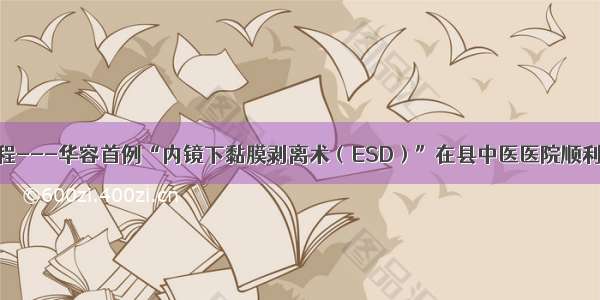
Mucosal Defect Closure by Endoscopic Hand-Suturing may Reduce Bleeding Risk after Gastric Endoscopic Submucosal Dissection: A Multicenter Pilot Study
内镜下手工缝合术(EHS)闭合黏膜缺损可降低胃内镜黏膜下剥离术(ESD)后出血风险:一项多中心先导性研究
导读:胃内镜黏膜下剥离术(ESD)后出血是一个迫切需要解决的问题,尤其是现在因其他疾病需要服用抗血栓形成剂(ATA)的患者越来越多。来自日本医科大学(Nippon Medical School)的Osamu Goto教授等人进行了一项多中心前瞻性研究,评估了通过内镜下手工缝合术(EHS)闭合黏膜缺损对于预防胃ESD术后出血的可行性、安全性和有效性。研究发现,EHS在降低胃ESD术后出血风险方面是可行、安全且潜在有效的。但还需要进行进一步的前瞻性研究。
Introduction介绍
Compared with other endoscopic treatments, gastric endoscopic submucosal dissection (ESD) has a relatively high risk of adverse events. Postoperative bleeding is a particularly urgent issue to address, especially as the number of patients taking antithrombotic agents (ATAs) for other disorders is increasing. Endoscopic hand-suturing (EHS), which involves continuous linear suturing endoscopically by using a commercially available absorbable barbed suture and a prototype of a through-the-scope flexible needle holder, provides secure intraluminal mucosal closure and should decrease the risk of adverse events after gastric ESD.
与其他内镜治疗相比,胃内镜黏膜下剥离术(ESD)发生不良事件的风险相对更高。术后出血是一个迫切需要解决的问题,尤其是现在因其他疾病需要服用抗血栓形成剂(ATA)的患者越来越多。内镜下手工缝合术(EHS)即使用一种市面上有售的可吸收的带刺缝线和一种经内镜孔道的柔性持针器,在内镜下进行连续线性缝合的技术,该技术可提供安全的腔内黏膜闭合,并减少胃ESD术后发生不良事件的风险。
Aims & Methods目的&方法
We prospectively investigated the feasibility, safety and efficacy of EHS following gastric ESD, particularly for preventing post-ESD bleeding. Patients scheduled for gastric ESD at three institutions were prospectively recruited. Just after ESD, the mucosal defect was closed by EHS (Figure 1, 2). Endoscopy was performed on postoperative day (POD) 3 to assess maintenance of the closure. During postoperative week 3 to 4, the patients were interviewed as outpatients about any occurrence of delayed bleeding. The primary outcome was endoscopic assessment of adequately sustained closure of the defect on POD 3. Completeness of suturing, time required for suturing (min), number of stitches, occurrence of adverse events, and postoperative bleeding were also analyzed. Furthermore, bleeding was compared between patients who were or were not taking ATAs.
本研究前瞻性地研究了胃ESD后EHS的可行性、安全性和有效性,特别是在预防ESD后出血方面。研究前瞻性招募了计划在三家机构接受胃ESD的患者。ESD后,即通过EHS闭合黏膜缺损(图1、2)。术后第3天进行内镜检查以评估闭合的维持情况。术后3至4周,患者接受门诊,并向患者了解是否发生任何延迟出血。主要结局是术后第3天通过内镜评估的对黏膜缺损闭合的适当维持。还分析了缝合的完整性、缝合所需的时间(分钟)、缝合针数、不良事件的发生率和术后出血。此外,还比较了正在服用或未服用ATA患者的出血情况。
Results结果
Data from 30 patients (15 each who did or did not take ATAs) were analyzed. In all 15 patients with ATAs, these were continued periprocedurally. Mucosal closure by EHS was completed in 29 of 30 cases (97%) and was well maintained on POD 3 in 25 cases (84%). The mean time needed for suturing was 46.2 ±17.0 min, and a mean of 8.7±1.4 stitches were placed, indicating an average of 5.3 min/stitch. No severe adverse event related to EHS occurred. Emergency endoscopy was required for major postoperative bleeding in three cases (10%), including the one in which suturing had been incomplete. Excluding one patient with a remnant stomach, the other 24 with sustained closure had no bleeding, regardless of whether they did or did not take ATAs (0/11 and 0/13, respectively).
分析了来自30例患者(接受ATA和未接受ATA的患者各15例)的数据。所有接受ATA的15例患者在围手术期均继续接受ATA。30例患者中有29例(97%)通过EHS完成了黏膜缺损的闭合,25例(84%)患者术后3天闭合情况维持良好。缝合所需的平均时间为46.2±17.0分钟,缝合针数平均为8.7±1.4针,表明平均5.3分钟/针。没有发生与EHS相关的严重不良事件。3例(10%)患者术后发生严重出血并需要紧急内镜操作,其中1例患者缝合不完全。排除一例残胃患者,其余24例闭合情况维持良好的患者无论是否接受ATA,均未发生出血(分别为0/11和0/13)。
Conclusion结论
The findings in our multicenter study suggest that EHS is feasible, safe, and potentially effective in decreasing the risk of postoperative bleeding after gastric ESD. Complete and sustained closure of a post-ESD mucosal defect by EHS may prevent delayed bleeding, even in patients at high risk of bleeding because of antithrombotic treatment. Further prospective investigation is required to confirm the efficacy of EHS for this purpose. (Trial registration number: UMIN000033988)
该多中心研究结果表明,EHS在降低胃ESD术后出血风险方面是可行、安全且潜在有效的。通过EHS完全闭合黏膜缺损且维持良好的闭合情况可防止ESD术后延迟出血,这一点也适用于因接受抗血栓治疗而有较高出血风险的患者。但还需要进行进一步的前瞻性研究,以确认EHS在降低胃ESD术后出血方面的有效性。(注册号:UMIN000033988)
Figure 1. Endoscopic hand-suturing (EHS) just after gastric ESD.
图1.胃ESD术后内镜下手工缝合术。
A. ESD术后胃大弯处的黏膜缺损,B.可吸收带刺缝线通过套管进入胃部,C.从缺损远端边缘开始缝合,用持针器持针,持钳辅助,D.线性连续缝合,E.黏膜缺损完全闭合,F.术后第3天的缝合部位,黏膜缺损闭合情况维持良好。
Figure 2. Endoscopic hand-suturing for a mucosal defect just after gastric ESD.
图2.胃ESD后对黏膜缺损进行的内镜下手工缝合术。
Figure 3. Complete closure of the mucosal defect.
图3.黏膜缺损完全闭合。
文献信息:
Osamu Goto et al. Mucosal Defect Closure by Endoscopic Hand-Suturing may Reduce Bleeding Risk after Gastric Endoscopic Submucosal Dissection: A Multicenter Pilot Study. GASTROINTESTINAL ENDOSCOPY. Volume 91, No. 5S : .
















